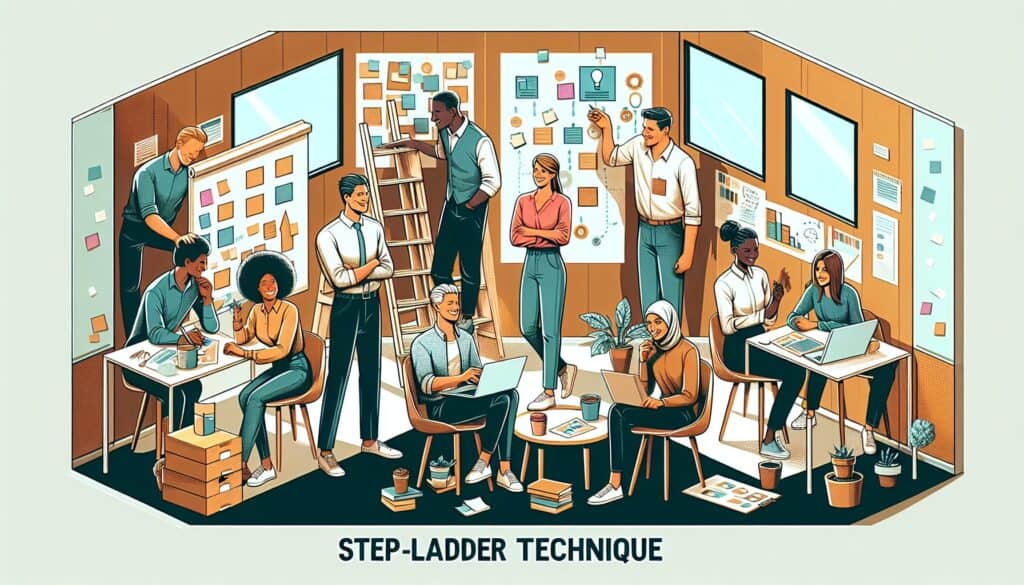Técnica estructurada de toma de decisiones en grupo o tormenta de ideas diseñada para garantizar que todos los miembros aportan sus ideas independientes antes de dejarse influir por el grupo.
- Metodologías: Ingeniería, Calidad
Técnica de la escalera

Técnica de la escalera
- Lluvia de ideas, Creatividad, Colaboración multifuncional, Pensamiento de diseño, Innovación, Técnicas de resolución de problemas, Trabajo en equipo, Diseño centrado en el usuario, Propuesta de valor
Objetivo:
Cómo se utiliza:
- Dos miembros del núcleo discuten el problema. A continuación, de uno en uno, otros miembros presentan sus ideas antes de escuchar el debate inicial. Tras la presentación de cada nuevo miembro, el grupo debate todas las ideas presentadas hasta el momento.
Ventajas
- Fomenta el pensamiento independiente de todos los miembros; ayuda a evitar el conformismo precoz o la dominación por parte de los individuos más asertivos; conduce a decisiones de mayor calidad en algunos casos.
Contras
- Puede llevar mucho tiempo, sobre todo con grupos grandes; requiere una gestión cuidadosa del proceso de entrada y debate; puede no ser adecuado para decisiones muy urgentes.
Categorías:
- Ideación, Resolución de problemas
Ideal para:
- Mejorar la toma de decisiones en grupo garantizando que todos los miembros aporten sus ideas individuales antes de dejarse influir por el grupo más amplio.
The Step-Ladder Technique is highly applicable in various sectors such as technology, healthcare, and automotive design, where teams are often tasked with solving intricate problems that require diverse perspectives for effective solutions. This methodology is particularly useful during the ideation phase of a project when the team is brainstorming solutions for new products or improvements. Typically, the process begins with two core members sharing their thoughts on the problem at hand, creating a baseline of ideas that new team members can build upon when they present their contributions one by one. This approach can involve engineers, designers, product managers, or even stakeholders who might impact the final decision. Each new member’s contribution is discussed in the context of previous suggestions, avoiding premature convergence on a single idea and ensuring that each voice is heard. This method promotes independent thought and minimizes the risk of groupthink, which is often prevalent in collaborative environments, especially when a few dominant personalities may sway the discussion. As such, companies using this technique often report enhanced creativity and innovation due to the varied viewpoints being considered. In settings where high-stakes decisions are required, such as clinical environments or product safety assessments, the Step-Ladder Technique can ensure that all sides of an issue are deliberated and that the final decision is informed by a comprehensive understanding of the problem, leading to more robust outcomes that reflect a wider range of experiences and expertise.
Pasos clave de esta metodología
- Two core members discuss the problem and generate initial ideas.
- Each additional member presents their ideas one at a time.
- After each new member presents, facilitate a discussion of all ideas shared so far.
- Encourage refinement and evaluation of ideas through further discussion.
- Continue this process until all members have contributed their ideas.
- Conclude the session with a comprehensive discussion incorporating all ideas shared.
Consejos profesionales
- Integrate role rotation within the group to enhance diverse viewpoints and counteract any single member's bias during discussions.
- Utilize time-boxing for each member's idea presentation to maintain engagement and encourage concise expressions of thoughts.
- Incorporate anonymous feedback mechanisms after discussions to assess satisfaction with solutions and further uncover any overlooked insights.
Leer y comparar varias metodologías, recomendamos el
> Amplio repositorio de metodologías <
junto con otras más de 400 metodologías.
Sus comentarios sobre esta metodología o información adicional son bienvenidos en la dirección sección de comentarios ↓ , así como cualquier idea o enlace relacionado con la ingeniería.
Contexto histórico
1960
1980
1983
1990
1995
2000
2010
1950
1980
1980
1986
1994
1995
2000
(si se desconoce la fecha o no es relevante, por ejemplo "mecánica de fluidos", se ofrece una estimación redondeada de su notable aparición)














Publicaciones relacionadas
Gestión de operaciones de fabricación (MOM)
Sistema de Ejecución de Fabricación (MES)
Plan de control de la fabricación
Pruebas manuales
Tablas de evaluación de la manipulación manual (MAC)
ManTRA (Herramienta de evaluación de riesgos en las tareas manuales)